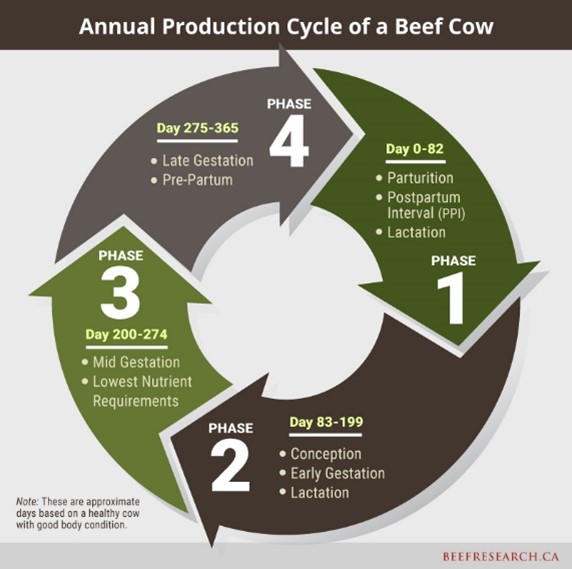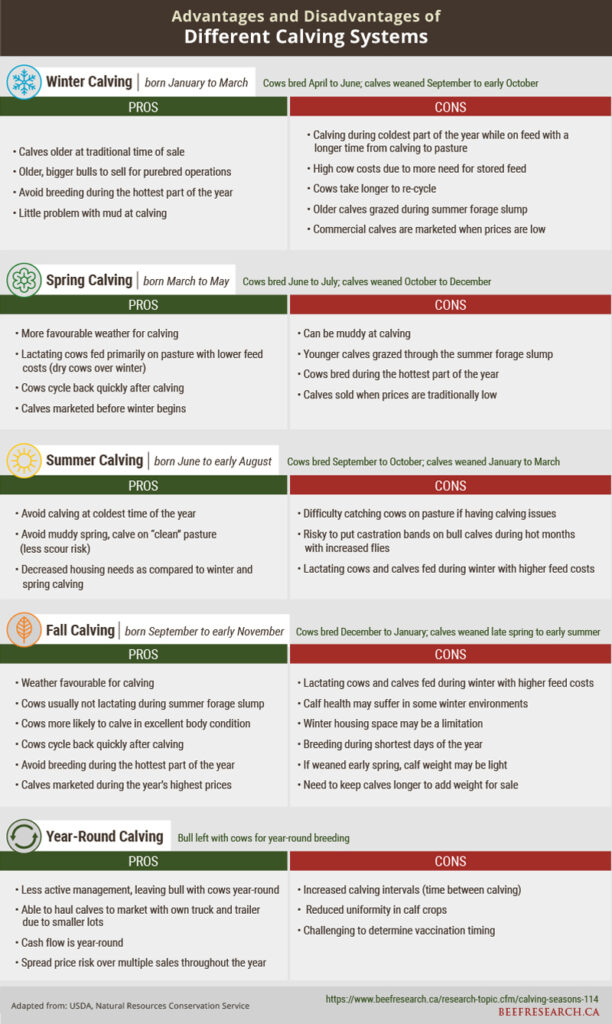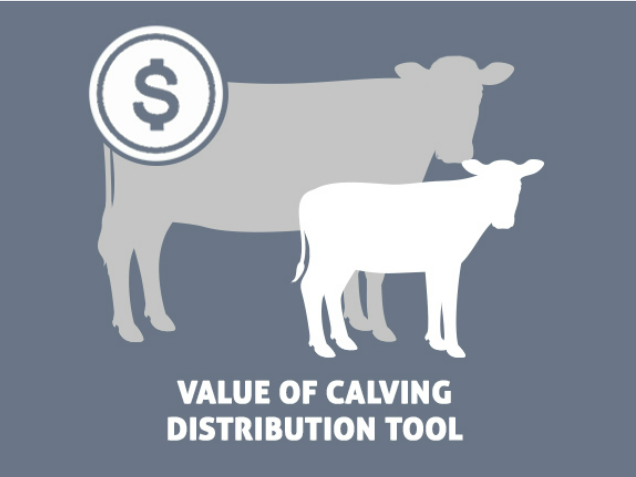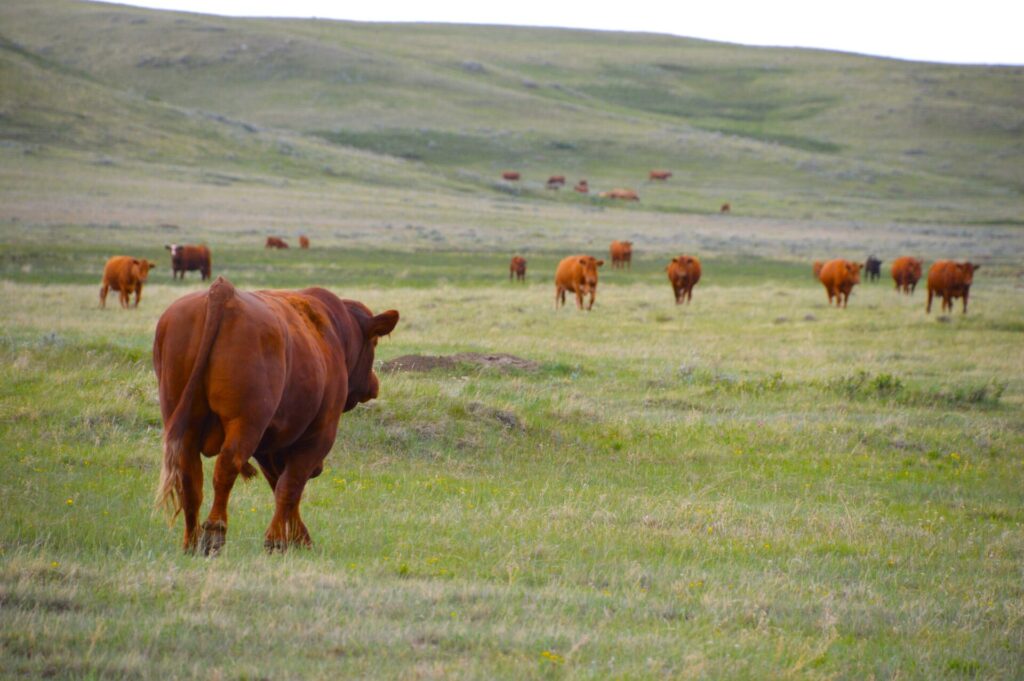A cow should have a calf every year. While that is a straightforward and simple statement, cattle producers know it takes effort, planning, and management to make this happen. One way to achieve this goal is to establish well-defined breeding and calving seasons.
| Key Points |
|---|
| A controlled calving season is a 60-90-day period in which all calves are born |
| A controlled calving period allows improved nutrient, health, and marketing management due to animal similarity throughout the year |
| Research has found that year-round calving results in lower returns to producers relative to spring and fall calving |
| A shorter breeding season may require adjusting the bull to cow ratio |
| Year-round marketing provides risk management as only a portion of the calf crop is sold at the annual low or high |
| For those planning to shorten their calving season or shift to an earlier time period, a slow adjustment is recommended to avoid negatively impacting conception rates |
Introduction

The key measures of success and the approach to improving herd reproductive performance will vary depending on the calving system. Cow-calf operators across Canada implement a range of calving seasons, including:
- Winter (early January through March),
- Spring (March through May),
- Summer (June to early August),
- Fall (September to early November), and
- Year-round (no defined calving period).
The 2016/17 Atlantic Cow-Calf survey reported that the average breeding season length for cows and heifers was 136 days, and average calving season length was 121 days. It was noted that some operations have year-long breeding and calving seasons.
Selecting a Calving Season
A controlled calving season is a 60-90-day period in which all calves are born. A defined calving season (spring or fall) has been shown to1:
- improve the uniformity of cattle for marketing,
- provide shorter time between calving in order for cows to have a calf every 12 months,
- reduce labour requirements at specific times of the year, which allows the farmer to focus on alternative enterprises such as crop and forage production,
- improve weaning weights (calves born in the first 21 days of the calving season are often the heaviest at weaning),
- help producers more accurately time vaccinations, such as a scours prevention vaccination, which needs to be given at a specific interval prior to calving, and
- reduce the variation in nutritional requirements within the herd at any one point in time.
All of this could help producers save money on herd inputs.
To assess your herd’s current calving distribution and evaluate the impact of moving to a more condensed calving season, learn more about and visit the Value of Calving Distribution Tool.
Overall, a controlled calving period allows improved nutrient, health (i.e., vaccination program), and marketing management due to uniformity or animal similarity throughout the year. Regardless of the time of year chosen, a controlled calving season provides clear time periods for when things happen on the farm.
In terms of timing (winter, spring, summer, fall), producers may match herd genetics to the environment by planning to provide the highest quality forages to the cow herd after calving and through the breeding season. However, in many cases there are additional considerations, such as other demands on labour that need to be accounted for.
Year-round calving or long calving seasons (five months or more) requires less active management, typically at the expense of increased calving intervals (time between calving). Research has found that year-round calving reduced returns to producers relative to spring and fall calving2. It was hypothesized however, that small-sized operations sacrificed returns to calving-season control for ease of management and the ability to avoid investment in facilities that would separate herd sires from the remaining breeding stock.
Read the BCRC’s post — One Size Doesn’t Fit All — for learnings from the Canadian Cow-Calf Cost of Production Network’s future farm scenario, simulating the potential costs and revenues of tightening the calving season over a five-year period.
For small herds considering transitioning to a defined calving season, the logistics of managing a bull can represent a significant barrier. The goal is to keep bulls in a separate and secure pasture or holding area to avoid accidental breedings, without caring for them becoming too challenging. One option is to share bulls with other producers so that they are only on the premises at the designated breeding time. This may be appealing if several neighbours are switching to a defined calving season and may assist in having an adequate number of bulls to breed the herd in the designated breeding period. A shorter breeding season may require adjusting the bull to cow ratio. (Note that the ideal bull to cow ratio will vary depending upon multiple factors including pasture size and conditions as well as concentration of the herd). Sharing bulls could make that feasible while addressing the question of where to keep bulls when not breeding. However, there are biosecurity considerations that should be discussed before bulls are shared between operations.
If year-round marketing is utilized, weaning weights might not suffer. Adjusting to a more seasonal cash flow can represent challenges if an operation is used to year-round marketing. Year-round marketing also provides risk management as only a portion of the calf crop is sold at the annual low or high.
Dual calving systems, such as part of the herd spring calving and the other part fall calving, allows for some specific management practices. For example, late calvers or open cows from one group can be shifted to the next. However, good records are needed to ensure that cows are not continually shifted between groups. Having a system where late calving cows can be shifted from a spring group to a fall group, but never vice-versa, can avoid that. This splits the labour requirements with fewer cows calving at a time. It also provides defined calving seasons that can accommodate weather issues such as mud.

How to Transition
For those planning to shorten their calving season or shift to an earlier time period, a slow adjustment is recommended to avoid negatively impacting conception rates. When shifting to an earlier calving season, producers may consider breeding first-calf heifers earlier than mature cows to allow a longer time to re-bred while also maintaining the desired calving season. However, this may require exposing more animals at a younger age to get the necessary conception rate.
Another option is to use hormone protocols to ensure heifers are bred earlier than cows or at the very beginning of the designated calving season. If you are looking to maintain a calving interval of fewer than 60 days, you don’t want heifers calving before the rest of the herd, but you can make sure they are at the very beginning of the calving period. In this situation, ensure that heifers are adequately developed at the time of breeding and are bred to a calving ease bull since they will be bred at just over a year old in most cases.
The most widely used procedure for converting from year-round calving to a defined calving season is to convert slowly over a three-year period (see table below), targeting the period when the majority of cows are already calving within the year-round cycle. This method usually results in a transition that does not require culling many cows in one year and is more economically feasible than transitioning in a single season. For some situations with high purchasing costs for bred heifers or raising replacements, an even slower transition might be deemed a better option.

If there are enough cows to run dual calving seasons, grouping based on initial pregnancy status can make the transition less costly. As mentioned above, doing this will create an opportunity to shift open cows to the other breeding season when they come open for the first time, provided there are no other reasons for culling (e.g., poor calf performance, udder/mastitis, lameness, etc.).
To read about firsthand experiences of producers who did their homework and planned ahead before shifting calving seasons, visit the BCRC blog: Calving Season Timing and Transition.
- References
-
1. Carpenter, B. and L.R. Sprott. Long Calving Seasons: Problems and Solutions. AgriLife Extension, Texas A&M System. B-1443. 6/07. Available here.
2. Doye, D., M. Popp, and C. West. “Controlled versus Continuous Calving Seasons in the South: What’s at Stake?”. Journal of the American Society of Farm Managers and Rural Appraisers. 90(2008):60–73.
Acknowledgements
Thank you to Brenna Grant, Manager, Canfax Research Services, for contributing her time and expertise in writing this page.
Feedback
Feedback and questions on the content of this page are welcome. Please e-mail us.
Expert Review
This content was last reviewed October 2022.
This content was last reviewed June 2023.

